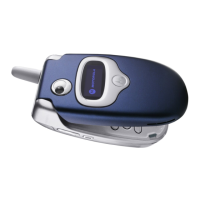6809468A80 September 30, 2003 47
Level 1 and 2 Service Manual Troubleshooting
4. Incoming call alert transducer audio
distorted or volume is too low.
Faulty transceiver board assembly. Replace the transceiver board assembly (refer
to 1c). Verify that the fault has been cleared and
reassemble the unit with the new transceiver
board assembly.
5. Telephone transmit audio is weak.
(usually indicated by called parties
complaining of difficulty in hearing voice).
a) Microphone connections to the
transceiver board assembly defective.
Gain access to the microphone as described in
the procedures. Check connections. If connector
is faulty proceed to c; if the connector is not at
fault, proceed to b.
b) Microphone defective. Gain access to microphone. Disconnect and
substitute a known good microphone. Place a
call and verify improvement in transmit signal as
heard by called party. If good, reassemble with
new microphone. If microphone is not at fault,
reinstall original microphone and proceed to c.
c) Transceiver board assembly
defective.
Replace the transceiver board assembly (refer
to 1c). Verify that the fault has been cleared and
reassemble the unit with the new transceiver
board assembly.
6. Receive audio from earpiece speaker is
weak or distorted.
a) Connections to or from transceiver
board assembly defective.
Gain access to the transceiver board assembly
as described in the procedures. Check flex and
the flex connector from the flip assembly to the
transceiver board assembly. If flex is at fault,
replace flip assembly. If flex connector is at fault,
proceed to d. If connection is not at fault,
proceed to b.
b) Flip assembly defective. Temporarily replace the flip assembly with a
known good assembly. If fault has been cleared,
reassemble with the new flip assembly. If fault
not cleared, proceed to c.
c) Antenna assembly defective. Check to make sure the antenna is installed
correctly. If the antenna is installed correctly,
substitute a known good antenna assembly. If
this does not clear the fault, reinstall the original
antenna assembly and proceed to d.
d) Transceiver board assembly
defective.
Replace the transceiver board assembly (refer
to 1c). Verify that the fault has been cleared and
reassemble with the new transceiver board
assembly.
7. Telephone will not recognize or accept
SIM.
a) SIM defective. Check the SIM contacts for dirt. Clean if
necessary and check if fault has been cleared. If
the contacts are clean, insert a known good SIM
into the telephone. Power up the unit and
confirm that the SIM has been accepted. If the
fault no longer exists, replace the defective SIM.
If the SIM is not at fault, proceed to b.
b) Flip assembly defective. Temporarily replace the flip assembly with a
known good assembly. If fault has been cleared,
reassemble with the new flip assembly. If fault
not cleared, proceed to c.
c) Transceiver board assembly
defective.
Replace the transceiver board assembly (refer
to 1c). Verify that the fault has been cleared and
reassemble the unit with the new transceiver
board assembly.
Table 4. V300 Telephone: Level 1 and 2 Troubleshooting Chart (Continued)
SYMPTOM PROBABLE CAUSE VERIFICATION AND REMEDY

